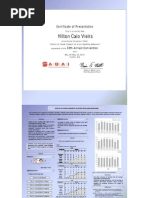Erhardt Developmental Prehension Assessment Pdf Merge


The purpose of this study was to evaluate inter-rater reliability and validity of a proposed functional outcome battery for clinical trials in children with Sturge-Weber syndrome (SWS).Ten children were evaluated twice on the same day using a series of functional outcome measures selected for sensitivity to the range of age and function of children with SWS: Modified Rankin Scale, Pediatric Evaluation of Disability Index, Modified House Functional Classification, and a modified version of the Erhardt Developmental Prehension Assessment. Inter-rater reliability was calculated, and criterion validity was explored through correlations with the Sturge-Weber Syndrome-Neurological Rating Score (SWS-NRS).Inter-rater reliability was high across all measures. Correlations were identified between the SWS-NRS and the study measures.The proposed battery of functional outcome measures captures child's functioning at the levels of impairment, activity and participation and is robust to evaluation by different raters and across sessions on the same day. This battery is expected to be sensitive to treatment-related changes in qualitative patterns of hand use, functional skills, and/or change in independence in daily living. Methods 10 children were evaluated twice on the same day using a series of functional outcome measures selected for sensitivity to the range of age and function of children with SWS: Modified Rankin Scale, Pediatric Evaluation of Disability Index, Modified House Functional Classification, and a modified version of the Erhardt Developmental Prehension Assessment. Inter-rater reliability was calculated, and criterion validity was explored through correlations with the Sturge-Weber Syndrome-Neurological Rating Score (SWS-NRS).
Introduction Sturge-Weber Syndrome (SWS) is a rare neurocutaneous disorder that frequently results in functional deficits. As clinical trials begin in SWS, a battery of functional outcome measures will be needed that is applicable to the heterogeneous population of SWS patients. Our goal is to propose and validate a battery of measures that quantifies upper extremity motor skills and independence with daily activities and measures function across the domains of impairment, activity and participation. Windows Vista Home Basic Ita Iso Download. Suede Coming Up Deluxe Edition Torrent here.
Observations to produce the Erhardt Developmental Vision Assessment (EDVA), following the same format as the Erhardt Developmental Prehension Assessment. THE RELIABILITY AND VALIDITY OF THE ERHARDT DEVELOPMENTAL PREHENSION ASSESSMENT Nancy Pollock A thesis submitted ta. Theories and Issues in Child. Alan Slater, Ian Hocking, and Jon Loose. KEY CONCEPTS. Ages of dynamic systems theory according to which motor development is a product of the interplay. Recently, Flavell (1996) wrote an assessment of.
Due to brain involvement in SWS, functional deficits frequently result and may be due to hemiparesis or other motor impairments, cognitive/behavioral dysfunction, epilepsy, and/or visual field cut [,,,]. Prior work has highlighted significant variability in clinical presentation of children with SWS [,]. Furthermore, individuals with SWS may show notable changes in function in association with seizures and stroke-like episodes []. The underlying somatic mosaic mutation for SWS has been recently reported [], providing important insights into pathogenesis and potential targets for treatment strategies.
Download 1992 Pontiac Firebird Owners Manual there. As therapeutic strategies for Sturge-Weber Syndrome are being proposed [e.g. [,]] and targeted, the field is preparing for clinical trials in this population. Along with important measures of disease severity, such as frequency of seizures and stroke-like events, an important goal of intervention is maintenance or improvement of functional skills. Clinical studies will thus need to incorporate a battery of functional outcome measures, which are sensitive to the range of function observed in this population and demonstrate reliability over multiple administrations.
Given the rarity of SWS, it is anticipated that clinical trials will enroll individuals over a broad age range and functional level. Furthermore, given that therapy may be most effective if started at a very young age, prior to onset of seizures and/or acquired functional deficits, the ability to assess the functional status of infants will be important. Additionally, ideal assessments will make use of readily available items, allowing for cost-effective assessment of children in a multi-site project. We performed an extensive literature search for common measures of upper extremity and activities daily living (ADL) function. Of the assessments identified, many possible measures were limited by the need to capture the function of very young children. Based on the identified importance of using outcome measures across the World Health Organization (WHO) International Classification of Functioning to characterize pediatric neurological disorders [], we chose an assessment battery that would evaluate functioning at the impairment, activity and participation levels. The WHO defines impairment as a problem in the structure or function of the body, activity as the performance of an action or task by a person, and participation as engagement in a life situation [,].